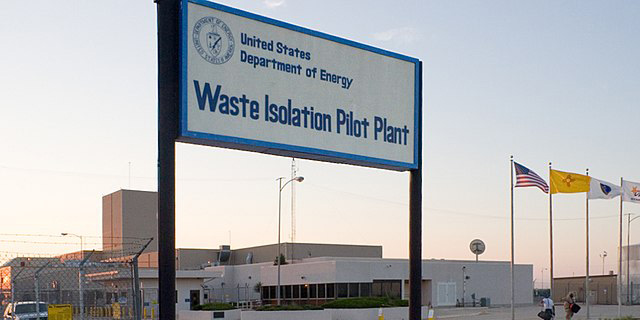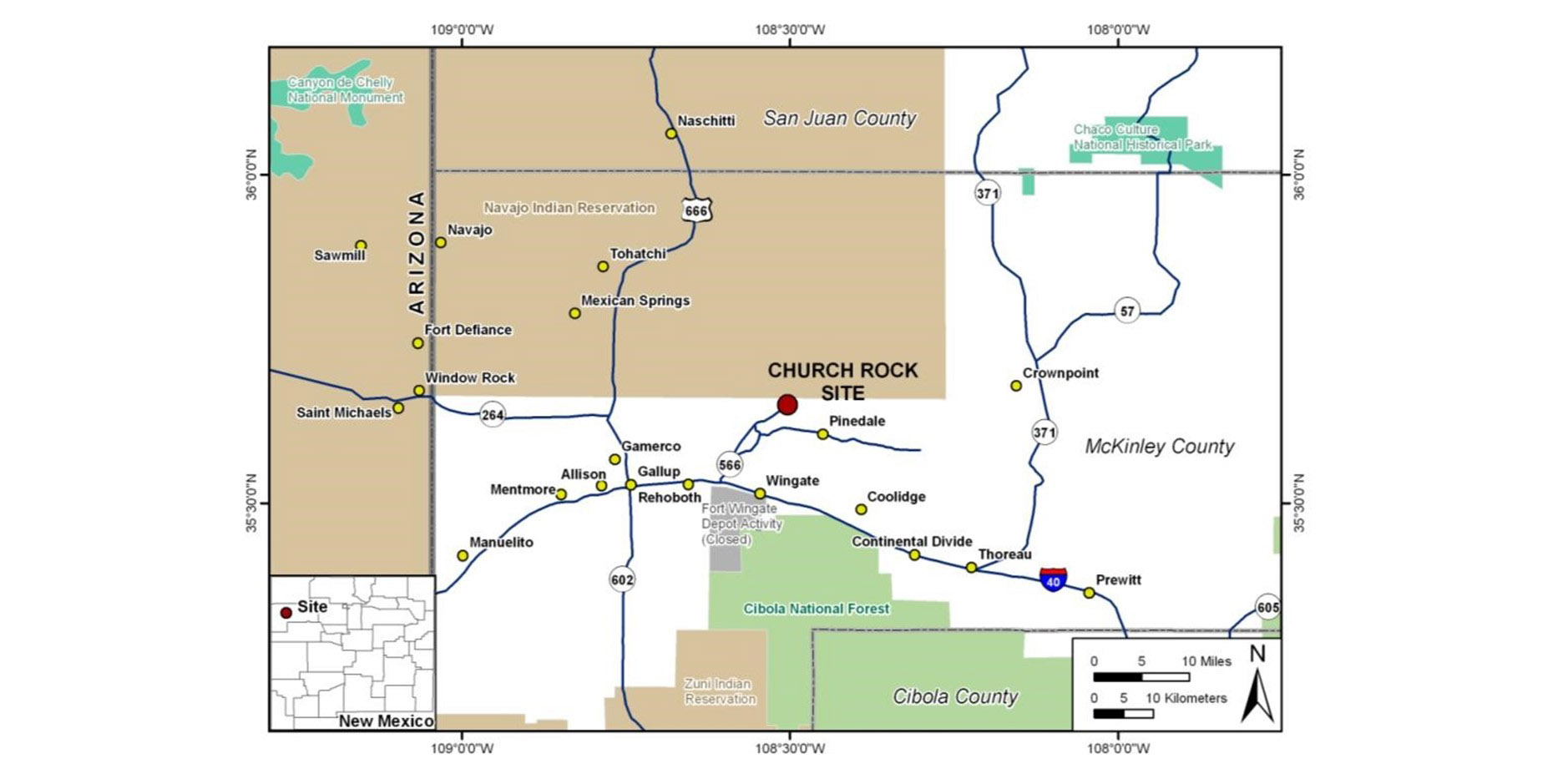A loaded MP197HB cask is prepared for departure from the Vermont Yankee decommissioning site to West Texas. (Photos: Orano TN)
The rapid changes in the nuclear energy industry over the last decade, driven in part by fluctuating energy market prices and an aging fleet of reactors, have led to the closure of multiple reactors in the United States and other countries. These closures have increased the need for larger and more efficient ways to manage low-level radioactive waste processing and transport capacities. The safe transport of radioactive material is a key component of the overall nuclear industry reliability. Though sometimes perceived as a bottleneck and costly, it is necessary to send waste material to disposal.
The Galloway is lowered into the utility shaft at WIPP. (Photo: DOE)
Progress continues on a new utility shaft at the Department of Energy’s Waste Isolation Pilot Plant in New Mexico as shaft-sinking crews recently surpassed the midway point at a depth of 1,076 feet. When complete, the full shaft depth will be 2,275 feet, with the team now halfway to the WIPP repository depth of 2,150 feet.
A rendering of Holtec’s proposed HI-STORE CISF in New Mexico. (Image: Holtec)
New Mexico has passed legislation aimed at preventing Holtec International from constructing and operating a consolidated interim storage facility (CISF) for spent nuclear fuel in the state. On March 17, hours after being passed by the New Mexico House on a 35-28 vote, Democratic Gov. Michelle Lujan Grisham signed SB 53, which prohibits the storage and disposal of radioactive waste in New Mexico without the state’s consent.
Using GeoMelt ICV technology to treat and immobilize problematic low-level wastes at INL and WCS.
A sample of GeoMelt glass. (Photos: Veolia)
When it comes to managing nuclear waste, technology is transforming the way some of the most problematic waste is handled. The idea to transform nuclear waste into glass was developed back in the 1970s as a way to lock away the waste’s radioactive elements and prevent them from escaping. For more than 40 years, vitrification has been used for the immobilization of high-level radioactive waste in many countries around the world, including the United States.
The first silo emptying machine installed in the Magnox Swarf Storage Silo at the U.K. Sellafield site. (Photo: Gov.UK)
The second of three machines that will be used to safely remove waste from the Magnox Swarf Storage Silo at the Sellafield nuclear site in the United Kingdom has successfully been assembled, it was announced by Sellafield Ltd., a subsidiary of the U.K. government’s Nuclear Decommissioning Authority.
A video showing how waste is removed and the Magnox Swarf Storage Silo prepared for decommissioning has been posted to YouTube and can be found here.
Concrete blocks are loaded onto a metal base and transporter during tests on a gantry crane system that will lift replacement melters for Hanford’s WTP. (Photo: DOE)
The Department of Energy has announced that tank operations contractor Washington River Protection Solutions (WRPS) and subcontractor Atkins are making progress at the Hanford Site in Washington state in their preparations to provide replacement melters to treat radioactive and chemical tank waste for the site’s Direct-Feed Low-Activity Waste program.
The Waste Isolation Pilot Plant in southeastern New Mexico. (Photo: DOE)
Waste management startup Deep Isolation announced that it has entered into a mentor-protégé agreement with Salado Isolation Mining Contractors (SIMCO), the new Bechtel National–led management and operations contractor for the Department of Energy’s Waste Isolation Pilot Plant in New Mexico.
A 3D view of the TN Eagle used fuel cask. (Image: Orano)
Orano Group subsidiary Orano NPS announced that Swiss electrical utility Axpo has selected the company to provide its TN Eagle used nuclear fuel casks over the entire operating period of the Leibstadt nuclear power plant in Switzerland.
February 17, 2023, 3:03PMRadwaste SolutionsPeter Swift, Michael Apted, Lake Barrett, John Kessler, and Steven Nesbit An electric continuous miner machine cuts out a waste-emplacement panel at the Waste Isolation Pilot Plant salt repository in New Mexico. (Photo: DOE)
Used nuclear fuel and high-level radioactive wastes are by-products of nuclear energy production and other applications of nuclear technology, and the consensus approach to disposing of those wastes safely is to encapsulate them and emplace them in stable geologic formations (geologic repositories) where they will be isolated from people and the environment for very long periods of time. The federal government has established environmental standards for waste isolation that any proposed geologic repository must meet.
In July 2021, the American Nuclear Society established a special committee to consider possibilities for revised generic environmental standards for disposal of spent nuclear fuel and high-level radioactive waste in the United States. The committee developed a number of recommendations, which are contained in a draft report that was to be issued in February for review and comment by stakeholders. The draft report can be found on the ANS website, at ans.org/policy/repositorystandard/.
The committee’s draft recommendations are based on two underlying assumptions. First, that the relevant legislative framework for regulation defined in the Nuclear Waste Policy Act (NWPA) remains unchanged. Specifically, it is assumed that the Environmental Protection Agency will be charged with promulgating environmental standards for disposal and that the Nuclear Regulatory Commission will be charged with reviewing applications for disposal facilities using licensing requirements and criteria consistent with the EPA standards. Second, that existing generic disposal standards will be updated or replaced.
Comments due April 14 for draft report aimed at revisiting EPA regulations
LA GRANGE PARK, Illinois – Today, the American Nuclear Society (ANS) released draft recommendations on updating public health and safety standards for the permanent disposal of commercial used nuclear fuel and high-level radioactive waste at future geological repository projects in the United States. The draft report provides a recommended framework for revisiting U.S. Environmental Protection Agency (EPA) geologic repository standards.
A map of the Church Rock uranium mill site location. (Image: NRC)
The Nuclear Regulatory Commission has approved a plan by United Nuclear Corp. (UNC) to dispose of mine waste from the Northeast Church Rock mine site in New Mexico at the company’s nearby uranium mill and tailings disposal site.
Two empty waste tanks weighing more than five tons each were transported from outside the Hanford Site’s Effluent Treatment Facility to an on-site landfill. (Photo: DOE)
Two large tanks near the Effluent Treatment Facility (ETF) at the Department of Energy’s Hanford Site in Washington state were removed recently to make way for future wastewater treatment activities at the ETF.
Savannah River’s DWPF has completed the conversion from formic acid to glycolic acid in the waste vitrification process. (Photo: DOE)
The Defense Waste Processing Facility (DWPF) at the Department of Energy’s Savannah River Site (SRS) in South Carolina has resumed operations after a completing a processing improvement that the DOE said will enable safer operations and more efficient vitrification of radioactive waste.
The Waste Isolation Pilot Plant in southeastern New Mexico. (Photo: EPA)
Salado Isolation Mining Contractors (SIMCO), a single-purpose entity comprised of Bechtel National and Los Alamos Technical Associates as a teaming contractor, has assumed responsibility for managing and operating the Waste Isolation Pilot Plant in New Mexico.

















